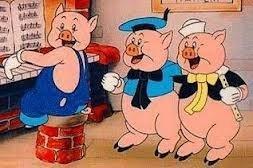
From Disney’s Silly Symphonies
There was an old sow who had three little pigs, and as she had not enough to keep them, she sent them out to seek their fortune…
The story of the Three Little Pigs has been around, it seems, just about forever. Everyone knows the wolfs sinsiter refrain of ‘little pig, little pig, let me come in…’. It may come as a surprise, then, that the earliest known printing of the tale is as late as 1849, in Halliwell’s Popular Rhymes and Nursery Tales.
Wonderfully parodied in David Fischer’s 1996 short story USA v. Wolf: Deposition of Mr. Wolf (which can be found in ">Legally Correct Fairy Tales), as well as Roald Dahl’s famous verse, the Three Little Pigs in its most basic form is an arrangement of a number of common fairy- and folktale tropes: the mystical, suspenseful number three; the Big Bad Wolf; the young lad(s) leaving home to seek their fortune; the threat of being eaten; living ‘happily ever after’. The tropes are moulded here into a warning against arrogance that encourages hard work and wit. Often, but not always, there is a mother knows best moral included too.
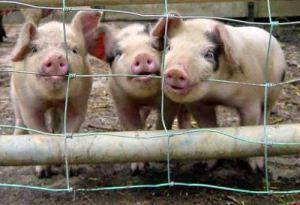
Pigs, 3, little. (from http://www.farminguk.com)
The two most common variants of the tale in the UK involve the consumption or otherwise of the first and second piggies. In one variant the first piggy escapes from his house of straw and the second piggy escapes from his house of twigs before being eaten. Together at the third piggies house – the house of bricks – the piggies set a pot of water boiling on the fire and the wolf falls down the chimney into it. The piggies then may or may not make soup from the wolf. This is the variant that appears in Halliwell.
In the other, slightly less common, variant the first and second pigs are eaten, only to be rescued from the belly of the wolf by piggy number three. This version is similar to the Italian tale of the Three Three Goslings (Il tre paperi).
Naturally, versions of the tale exist across cultures. Turkey has The Three Hares (üç tavşan); India has Lambikin and France The Three Pullets (which can be found in the Borzoi book of French folk tales) to name only a few. The Grimm’s tale, The Wolf and the Seven Little Kids (Der Wolf und die sieben Geißlein), while not classified as a variant shares some similarities with the tale.
The three versions I look at today tend towards satire. I’ve included Richard Johnson’s version as an example of the traditional retelling (while it’s not the best, it’s the one I had to hand). The other two represent modern subversions.
Three Little Pigs; Richard Johnson
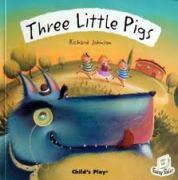
Three Little Pigs
We begin with a straightforward retelling of the tale by Richard Johnson. This is " target="_blank">an interactive, lift-the-flap affair that reveals the wolf lurking on every page. Here the emphasis is on danger; Mother Pig warns her piglets on page one to beware the wolf who would love to eat them up.
There’s not much to say about this version of the tale. It follows the down-the-chimney variant closely and uses a palette of muted blues and oranges to illustrate the text. The images add little that cannot be understood from the words on the page, and while it’s nice that it’s the female piglet that displays the (often coded male) attributes of common sense, physical ability and leadership, the book is solid but nothing special.
The True Story of the 3 Little Pigs by A. Wolf; Jon Scieszka, Lane Smith (illus.)
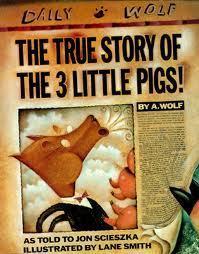
The True Story of the Three Little Pigs by A. Wolf
" target="_blank">The True Story of the 3 Little Pigs is a great post-modern picture book. It’s rich with parody and self-reference, breaking some of the rules of the form and respecting others. The story is told from the perspective of the wolf, who claims to be a misunderstood victim of profiling who got caught up in a bad situation. He didn’t blow the houses down, he sneezed! He only ate the pigs because that’s his nature! His story was half invented by journalists, he’s not really a bad wolf.
The story is certainly relevant today, as we debate the role the press plays in our lives and what really does constitute truth.
Here, instead of the pigs, wolfie is both protagonist and victim. But he’s not a reliable storyteller and he’s speaking from his jail cell. Is he to be believed? Lane Smith’s illustrations show that this world is inhabited mainly by pigs, and they’re not all as cute as they’re made out to be. So who can we trust?
Illustrations are contained within strictly marked spaces on a traditionally set page, but the black lines that contain the images are undulating, suggesting uncertainty as to the truth of the illustrations they contain. Text sometimes sits outside of the story space, sometimes within it. There is an overwhelming sense of ambiguity on the page as text and image compete to show us their version of the truth.
Ultimately it is for the reader to decide which version of the story to believe.
The Three Little Wolves and the Big Bad Pig; Eugene Trivizas, Helen Oxenbury (illus.)
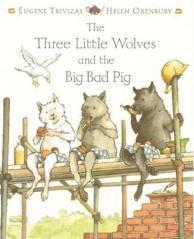
The Three Little Wolves and the Big Bad Pig
In this " target="_blank">subversion of the story illustrated by Helen Oxenbury roles are reversed. The little wolves are soft creatures who display love and caring, sticking together throughout the story and heeding their mothers warning to beware the ‘big bad pig’.
The colours of Three Little Wolves (black, grey and white) reveals the debt to Andrew Lang’s famous version of the tale in The Green Fairy Book (1892). Here, though, instead of going the traditional route, the wolves build first in brick, then in concrete, before building something close to a nuclear fallout shelter. Still they cannot keep out the increasingly violent pig.
Finally, the wolves build a house of flowers. The character of the pig is transformed by the power of aromatherapy.
… as he took a deep breath, ready to huff and puff, he smelled the soft scent of the flowers. It was fantastic. And because the scent took his breath away, the pig took another breath and then another. Instead of huffing and puffing, he began to sniff.
He sniffed deeper and deeper until he was quite filled with the fragrant scent. His heart became tender and he realized how horrible he had been in the past. In other words, he became a good pig. He started to sing and dance the tarantella.
It is not only the protagonists and antagonists that are switched, but the security of the respective homes too. The most secure house of the original tale becomes the least secure as the house of flowers promotes understanding, friendship and kindness and resolves the conflict without violence.
There is no need for the wolves to boil the Big Bad Pig alive; just as the wolves have changed their thinking in building a house of flowers, the pig is capable of changing too.
The emphasis on cooperation and the healing power of nature gives Trivizas’s text an air of positivity which is continued in Helen Oxenbury’s watercolour illustrations. The incongruity of seeing a pig with a pneumatic drill rendered in calm and pale watercolour adds humor and paves the way for the final pages in which the animals come together.
The Three Little Wolves and the Big Bad Pig is now 20 years old but it does not feel dated. It’s message is still relevant, it’s illustrations still feel fresh. It’s a classic and deservedly so.
Bonus material: The Cannes Lion Award winning Guardian newspaper advert which turns the story of the Three Little Pigs into a gritty modern news story.
